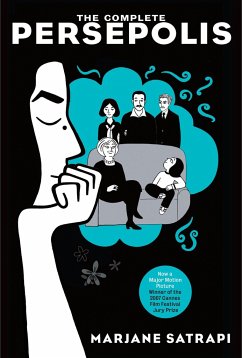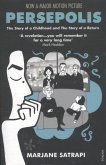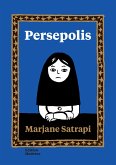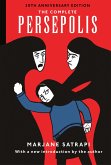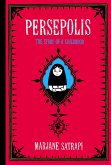Here, in one volume: Marjane Satrapi's best-selling, internationally acclaimed graphic memoir of growing up as a girl in Iran during the revolution has for twenty years been a classroom staple, a feminist manifesto, and one of the most popular and widely known graphic novels of all time.
"A stunning graphic memoir...a wholly original achievement in the form." The New York Times
Persepolis is the story of Satrapi's unforgettable childhood and coming of age within a large and loving family in Tehran during the Islamic Revolution; of the contradictions between private life and public life in a country plagued by political upheaval; of her high school years in Vienna facing the trials of adolescence far from her family; of her homecoming both sweet and terrible; and, finally, of her self-imposed exile from her beloved homeland. It is the chronicle of a girlhood and adolescence at once outrageous and familiar, a young life entwined with the history of her country yet filled with the universal trials and joys of growing up.
Edgy, searingly observant, and candid, often heartbreaking but threaded throughout with raw humor and hard-earned wisdom Persepolis is a stunning work from one of the most highly regarded, singularly talented graphic artists at work today.
"A stunning graphic memoir...a wholly original achievement in the form." The New York Times
Persepolis is the story of Satrapi's unforgettable childhood and coming of age within a large and loving family in Tehran during the Islamic Revolution; of the contradictions between private life and public life in a country plagued by political upheaval; of her high school years in Vienna facing the trials of adolescence far from her family; of her homecoming both sweet and terrible; and, finally, of her self-imposed exile from her beloved homeland. It is the chronicle of a girlhood and adolescence at once outrageous and familiar, a young life entwined with the history of her country yet filled with the universal trials and joys of growing up.
Edgy, searingly observant, and candid, often heartbreaking but threaded throughout with raw humor and hard-earned wisdom Persepolis is a stunning work from one of the most highly regarded, singularly talented graphic artists at work today.
Praise for Persepolis: Volume 1
A New York Times Notable Book A Time Magazine Best Comix of the Year A San Francisco Chronicle and Los Angeles Times Best Seller
"A memoir of growing up as a girl in revolutionary Iran, Persepolis provides a unique glimpse into a nearly unknown and unreachable way of life.... That Satrapi chose to tell her remarkable story as a gorgeous comic book makes it totally unique and indispensable." Time
Delectable... Dances with drama and insouciant wit. The New York Times Book Review
A stunning graphic memoir hailed as a wholly original achievement in the form. There s still a startling freshness to the book. It won t age. In inky shadows and simple, expressive lines reminiscent of Ludwig Bemelmans s Madeline Satrapi evokes herself and her schoolmates coming of age in a world of protests and disappearances ... A stark, shocking impact. Parul Sehgal, The 50 Best Memoirs of the Past 50 Years The New York Times
A dazzlingly singular achievement.... Striking a perfect balance between the fantasies and neighborhood conspiracies of childhood and the mounting lunacy of Khomeini's reign, she's like the Persian love child of Spiegelman and Lynda Barry. Salon
A brilliant and unusual graphic memoir.... [Told] in a guileless voice ... accompanied by a series of black-and-white drawings that dramatically illustrate how a repressive regime deforms ordinary lives. Vogue
"Odds are, you ll be too busy being entertained to realize how much you ve learned until you turn the last page. Elle.com
[A] self-portrait of the artist as a young girl, rendered in graceful black-and-white comics that apply a childlike sensibility to the bleak lowlights of recent Iranian history. . . . [Her] style is powerful; it persuasively communicates confusion and horror through the eyes of a precocious preteen. Village Voice
Praise for Persepolis: Volume 2
"Wildly charming ... Like a letter from a friend, in this case a wonderful friend: honest, strong-willed, funny, tender, impulsive, and self-aware."
The New York Times Book Review
"The most original coming-of-age story from the Middle East yet."
People
"Elegant, simple panels tell this story of growth, loneliness, and homecoming with poignant charm and wit."
The Washington Post
"Humorous and heartbreaking ... A welcome look beind the headlines and into the heart and mind of one very wise, wicked, and winning young woman."
Elle
"Every revolution needs a chronicler like Satrapi."
San Francisco Chronicle
"It is our good fortune that Satrapi has never stopped visiting Iran in her mind."
Newsweek
"Persepolis 2 is much more than the chronicle of a young woman s struggle into adulthood; it s a brilliant, painful, rendering of the contrast between East and West, between the repression of wartime Iran and the social, political, and sexual freedoms of 1980 s Austria. There s something universal about Satrapi s search for self-definition, but her experiences in Vienna and Tehran are rendered with such witty particularity, and such heartbreaking honesty, that by the end of this book you ll feel you ve gained an intimate friend."
Julie Orringer, author of How To Breathe Underwater
A New York Times Notable Book A Time Magazine Best Comix of the Year A San Francisco Chronicle and Los Angeles Times Best Seller
"A memoir of growing up as a girl in revolutionary Iran, Persepolis provides a unique glimpse into a nearly unknown and unreachable way of life.... That Satrapi chose to tell her remarkable story as a gorgeous comic book makes it totally unique and indispensable." Time
Delectable... Dances with drama and insouciant wit. The New York Times Book Review
A stunning graphic memoir hailed as a wholly original achievement in the form. There s still a startling freshness to the book. It won t age. In inky shadows and simple, expressive lines reminiscent of Ludwig Bemelmans s Madeline Satrapi evokes herself and her schoolmates coming of age in a world of protests and disappearances ... A stark, shocking impact. Parul Sehgal, The 50 Best Memoirs of the Past 50 Years The New York Times
A dazzlingly singular achievement.... Striking a perfect balance between the fantasies and neighborhood conspiracies of childhood and the mounting lunacy of Khomeini's reign, she's like the Persian love child of Spiegelman and Lynda Barry. Salon
A brilliant and unusual graphic memoir.... [Told] in a guileless voice ... accompanied by a series of black-and-white drawings that dramatically illustrate how a repressive regime deforms ordinary lives. Vogue
"Odds are, you ll be too busy being entertained to realize how much you ve learned until you turn the last page. Elle.com
[A] self-portrait of the artist as a young girl, rendered in graceful black-and-white comics that apply a childlike sensibility to the bleak lowlights of recent Iranian history. . . . [Her] style is powerful; it persuasively communicates confusion and horror through the eyes of a precocious preteen. Village Voice
Praise for Persepolis: Volume 2
"Wildly charming ... Like a letter from a friend, in this case a wonderful friend: honest, strong-willed, funny, tender, impulsive, and self-aware."
The New York Times Book Review
"The most original coming-of-age story from the Middle East yet."
People
"Elegant, simple panels tell this story of growth, loneliness, and homecoming with poignant charm and wit."
The Washington Post
"Humorous and heartbreaking ... A welcome look beind the headlines and into the heart and mind of one very wise, wicked, and winning young woman."
Elle
"Every revolution needs a chronicler like Satrapi."
San Francisco Chronicle
"It is our good fortune that Satrapi has never stopped visiting Iran in her mind."
Newsweek
"Persepolis 2 is much more than the chronicle of a young woman s struggle into adulthood; it s a brilliant, painful, rendering of the contrast between East and West, between the repression of wartime Iran and the social, political, and sexual freedoms of 1980 s Austria. There s something universal about Satrapi s search for self-definition, but her experiences in Vienna and Tehran are rendered with such witty particularity, and such heartbreaking honesty, that by the end of this book you ll feel you ve gained an intimate friend."
Julie Orringer, author of How To Breathe Underwater

